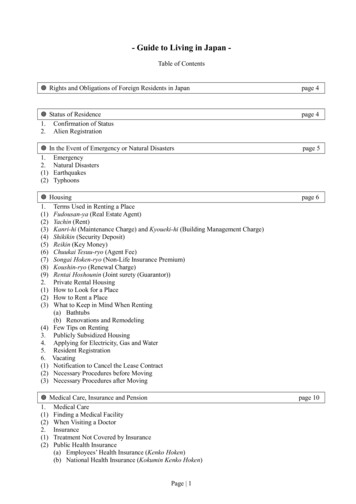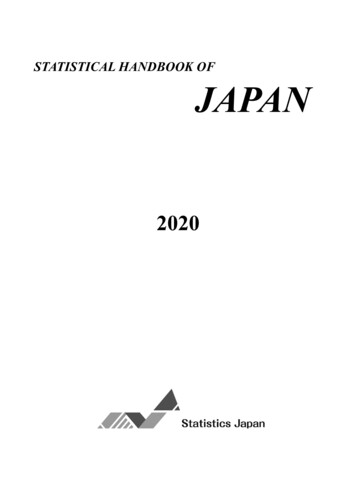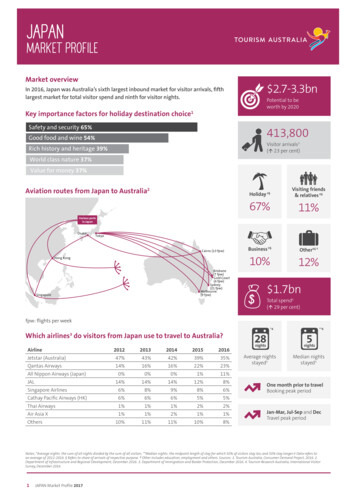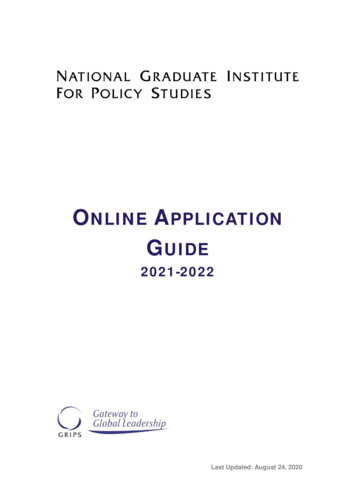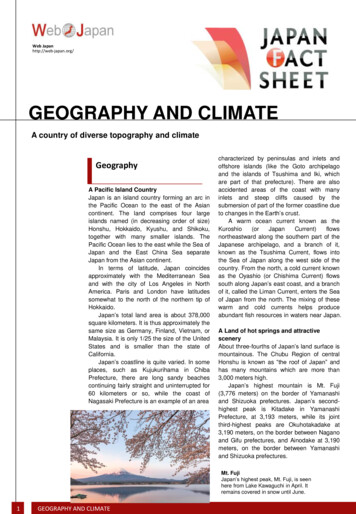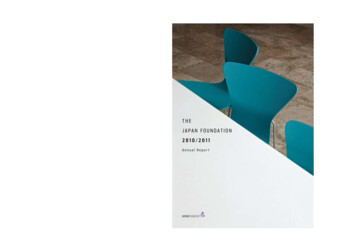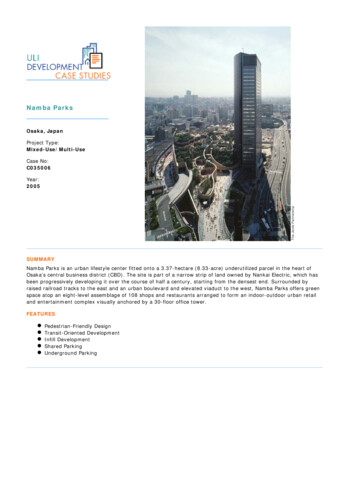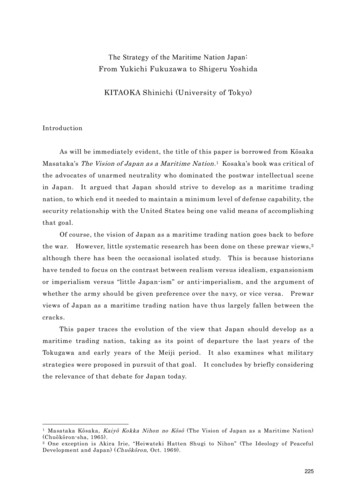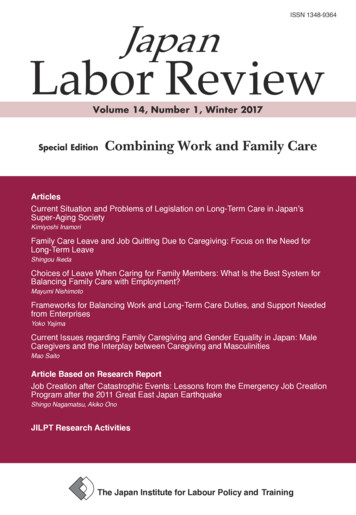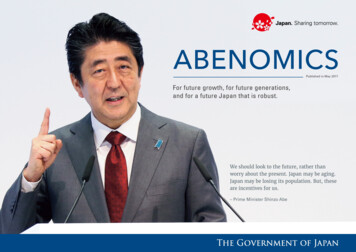
Transcription
ABENOMICSPublished in May 2017For future growth, for future generations,and for a future Japan that is robust.We should look to the future, rather thanworry about the present. Japan may be aging.Japan may be losing its population. But, theseare incentives for us.– Prime Minister Shinzo Abe
About AbenomicsINTRODUCTIONSetting the economy on course toovercome deflation and make a steadyrecovery with the Three ArrowsIn early 2013, after two decades ofeconomic stagnation, Prime MinisterShinzo Abe unveiled a comprehensiveeconomic policy package to sustainablyrevive the Japanese economy whilemaintaining fiscal discipline.This program became known asAbenomics.The centerpiece of Abenomics has beenthe three “policy arrows” targeted ataggressive monetary policy, flexible fiscalpolicy and growth strategy includingstructural reform.Since then, Abenomics has achievedremarkable progress.For example: Nominal GDP grew from 495 to 532trillion yen1 between the fiscal years of2012 and 20152 Annual corporate ordinary profitsincreased by 20 trillion yen betweenthe fiscal years of 2012 and 20153 Unemployment rate declined from4.3% to 3.1% between 2012 and 20164 Core CPI improved by 3.0% between2012 and 20165And now it is gaining speed. This documentoffers the latest on the reforms beingimplemented to reach a GDP of 600 trillionyen, including work style reform to raiseproductivity and increase the workforce inthe midst of demographic changes.1ABENOMICS(%)Nominal GDP and growth rate 2(JPY tril)3.02.5BEFORE 45185070500494495-0.5GDP (Expenditure Approach)(Right scale)-1.1400-1.5FY2011(JPY tril)FY2012FY2013Corporate ordinary profits orecast)Jobs to applicants ratioand unemployment rate44.56045.340(%) (JPY tril)1.43 4.54.01.252.81.000.750.740.920.25FY2011 FY2012 FY2013 FY2014 FY20153.02.50.50.020122013201420152016Job to applicants ratio (Left scale)Job to applicants ratio ofregular employees (Left scale)Unemployment rate (Right scale)2017Dependency ratio onJapanese Government Bonds6605040(%)57.7 0003.51.50.5020(Left scale)TARGET5.01.50Nominal GDP growth rate201000FY2011 FY2012 FY2013 FY2014 FY2015 FY2016 FY2017(Forecast)Amount of JGBs issued (Left scale)Tax revenues (Left scale)Level of dependence on JGBs (Right scale)1 Average exchange rate for March 2017: USD JPY 1132 Source: Cabinet Office “National Accounts”; “Fiscal 2017 Economic Outlook and Basic Stance for Economic and Fiscal Management”; The Japanese fiscal year starts in April andconcludes in March of the following year3 Source: Ministry of Finance “Financial Statements Statistics of Corporations by Industry,” all industries, all (firm) sizes, seasonally adjusted figures4 Source: Ministry of Health, Labour and Welfare “Statistics on Employment Referrals for General Workers,” seasonally adjusted figures; Ministry of Internal Affairs andCommunications “Labor force survey”5 Source: Statistics Bureau, Consumer Price Index. 1.3%, excluding the consumption tax rate change in April 2014. Core CPI All items, less food (less alcoholic beverages) and energy6 Source: Ministry of Finance ”Public Finance Statistics Book”
TOPIC: THE FY2017 BUDGETEngines that keep the positiveeconomic cycle spinningOpening the pathto the future:The budget to achieve economic growth whilemaintaining fiscal discipline was passed onMarch 27. The focuses for this fiscal year are:FURTHER STIMULATING THE ECONOMY Promote Industry 4.0 by encouraging privateinvestment in R&D in science and technology1 Promote inbound tourismCREATING A POSITIVE ECONOMICCYCLE OF GROWTH AND RE-DISTRIBUTION Increase disposable income by lowering theemployment insurance premium by 0.2%2 Expand childcare support by increasing thenumber of:»» childcare workers with improvedlabor conditions»» available childcare options Extend the childcare leave benefit from1.5 years to 2 years for those on the waiting list1BoostProductivityp. 3–4Boost productivity by changing workstyle and diversifying the labor forceto cope with the demographic changeLeads to wage increase andemployment, resulting in higherincome and a rise in consumption2Drive Innovationand Tradep. 5–8Implement structural reforms such asderegulation in the agricultural sectorand other areas with growth potential,as well as expand international tradeLeads to the creation of new demandand increased capital investment3Energize CorporateActivitiesp. 9–10Continue to create a business-friendlyenvironment and promote inward FDIthrough robust corporate governanceand further corporate tax reductionCREATING OPPORTUNITIES FOR CHILDREN Provide higher education for students fromchallenging economic circumstances by:»» Introducing a grant-type scholarship witha base of 30,000 yen per month»» Eliminating virtually all academicrequirements of interest-free scholarshiploans for students from low-income familiesREFORM WORK STYLETO INCREASE PRODUCTIVITY Encourage companies that are:»» Reforming their evaluation scheme»» Introducing equal pay for equal work»» Small and medium-sized enterprises(SMEs) introducing a minimuminterval system for working hoursLeads to rise in corporate performance1 Artificial intelligence (AI), robots, Internet ofThings (IoT), automated driving and cybersecurity2 For three years
1BOOSTPRODUCTIVITYTHE FIRST STEP IN REALIZING FUNDAMENTAL WORK-STYLE REFORMChange how we workIncreasing productivity andlabor participation are keys tosustaining economic growthunder the demographicchange that Japan isexperiencing. In realizing this,work-style reform is the biggestchallenge we need to tackle.Legislative rules and guidelines of “equal pay forequal work”: Eliminate the irrational gaps in the workingconditions between regular and non-regular workers in orderto enable non-regular workers to be fairly evaluated and towork with higher motivationsRegulatory limit on overtime work with penal regulations:Define the maximum hours of overtime work and reviselegislation that will concretely establish a limit that cannot beexceeded even in temporary and special situationsOn March 28, 2017, underPrime Minister Abe’s stronginitiative as chair, the Councilfor the Realization of WorkStyle Reform has formed apromising plan to realize asociety where everyone canchoose various and flexiblework styles.Human resource cultivation and supporting reemployment:Support relearning of individuals, such as by enabling women,who once take child-rearing leave, to receive recurrenteducation for skill improvement and re-employmentPromoting flexible work styles: Promote teleworking, sidejobs and multiple jobs with a variety of policy measures,including the renewal of guidelinesIntroducing new scholarship programs for children:Based on this plan, theAdministration will implementstructural and legislativetransformations.Establish new systems that will ease economic burdens toencourage children to attend higher education regardless ofeconomic statusWORK-STYLE REFORMPRODUCTIVITY GROWTH &PARTICIPATION RATE INCREASEImprovedcorporateperformanceDIVERSITY IN LABOR FORCE3ABENOMICSWage increaseEmploymentHigherincome
Embrace diversityFrom 2012 to 2016,the number of womenjoining the workforceincreased by aboutGiven the declining workpopulation Japan faces today,we need to include morepeople in the workforce.That is why our work andbusiness customs are in theprocess of being reassessed,and a wide range of workingopportunities is becomingaccessible to women, seniorcitizens and expatriates whosechances were limited before.WOMENLessen the burden of workingparents and accelerate women’spromotionMore information:http://www.japan.go.jp/women Secure additional childcarecapacity for approximately 500,000children by the end of FY2017 Increase childcare leave benefitsfrom 50% to 67%, applied to thefirst six months of leave1 Mandate businesses to discloseinformation on the employmentstatus of women and theirfuture targets Through collaboration with theTokyo Stock Exchange, selectand promote enterprises thatencourage women’s success in theworkplace as “Nadeshiko Brands” Provide female candidates withexecutive leadership trainingprograms from the world’sleading business scholars Further encourage recurrenteducation for women away onmaternity leave1 Law took effect in April 20142 Law took effect in September 20153 Law will take effect by November 27, 2017SENIORSFacilitate change throughengagement with businesses Provide a choice to extendretirement age for those whowant to work, as well as supportcompanies that extend the limit Provide support in matching jobopenings and applicationsEXPATRIATESLeverage legislative reforms topromote and expand opportunities Expedite permanent residency byintroducing “Japanese Green Card forHighly Skilled Foreign Professionals”to obtain visas after a year of arriving,under certain conditions1.5 millionSource: Ministry of Internal Affairs andCommunications: “Labor Force Survey”Women in managementpositions in the private sectorapproaches10%Source: Ministry of Health, Labour and Welfare:“Basic Survey on Wage Structure”71%of seniors reportthat they would like to continueto work past retirement ageSource: Cabinet Office, Annual Report onthe Aging society Promote expatriate entrepreneurshipin Tokyo, Niigata City, Fukuoka City,Sendai City, Aichi Prefecture andHiroshima Prefecture Increase expatriate housekeepingsupport workers in Tokyo, Kanagawaand Osaka by leveraging NationalStrategic Special Zones2 Expand job categories, increaseadmission quotas and extend trainingperiods from three to five years byrevising the current Technical InternTraining Program3Since May 2015, the numberof “highly-skilled foreignprofessionals”increased by97%(As of December 2016)Source: Ministry of Justice: “Number ofRecognitions of Highly Skilled Professionals”ABENOMICS4
DRIVE INNOVATIONAND TRADERealize Society 5.0Japan is a country renownedfor its technology and skilledworkers. We are rapidlymoving towards Society 5.0,adding a fifth chapter to thefour major stages of humandevelopment: (1) huntergatherer, (2) agricultural, (3)industrial and (4) information.In this new ultra-smart society,Japan will further expandnetworking and Internet ofThings (IoT) capabilitiesfrom advanced innovationsin manufacturing to everycorner of society, dramaticallyimproving quality of life andaccelerating economic growth.STARTUPBUSINESSESTECHNOLOGYContinue to maintain worldwideleadership in the technologyindustryEncourage entrepreneurialismnationwide through deregulationand supportMore information:http://www.japan.go.jp/innovationMore information:http://www.japan.go.jp/innovation Make it a government initiative togenerate 30 trillion yen of addedvalue by supporting growth in theareas of the IoT, big data, artificialintelligence (AI), robotics, etc. Facilitate business partnershipsbetween startups and universities Identify necessary regulatoryreforms under leadership of theCouncil*1 Establish special incentive measuresto promote venture investment Support talent developmentthrough exchange programs withSilicon Valley Support SMEs in adopting newtechnology such as robotics toimprove efficiency Accelerate data utilization to fosterareas such as autonomous drivingand drones Provide programming education atelementary and secondary schoolsto foster information literacyEXAMPLE IN TOKYO AREA:BUSINESS ESTABLISHMENTSPECIAL ZONES2Consolidate scattered registrationoutlets for different documentsinto one convenient outletTokyo One-Stop BusinessEstablishment Center(as of December 2016) Centralizes all applicationservices in TokyoIn September 2016, the Council* was established and taskedto compile a road map to realize Society 5.0 by mid FY2017* Growth Strategy Council (Chairman: PM Abe)PROF. SANKAI, UNIVERSITY OF TSUKUBA / CYBERDYNE INC.5ABENOMICS1 In February 2017, a subcommittee dedicated to the development of automated driving (technology,legislative systems, etc.) through the formulation of a Regulatory Sandbox System was set up in Tokyo Increased capabilities regardingthe handling of the Certificationof Eligibility forvisa applications4,393(As of March 2017)casescompleted
Leverage structural reformsENERGYExpand the market from16 trillion to 26 trillion yenby 2020Increase investments from18 trillion to 28 trillion yen byFY2030, addressing global warmingDouble the integrated market value1from 5.1 trillion to 10 trillion yenby 2020 Create a framework for private firmsto provide medical-related servicesnot covered by public insurance incooperation with insured medicalservices for integrated care Extend the “Energy EfficiencyBenchmark Program” to cover70% of annual energy consumptionof all industries Accelerate restructurings in thematerial production business(e.g. fertilizer, feed) and also in thedistribution business (e.g. wholesale) Maximize introduction of renewableenergy while minimizing thenational burden under the revisedFeed-in Tariff (FIT) Encourage cross-industrycollaboration to spur smart farming Alleviate nursing care burden byutilizing robots and sensors Provide customized healthcareservices based on personal datacollected by wearable devices Introduce new MMS* scheme toallow easier and affordable accessto advanced medical treatment*MMS The scenario where a patientreceives both insured and uninsured treatmentperformed in the same series of medical treatmentsLaw took effect in 2016 Promote business alliances through anew healthcare corporation systemLaw enacted in 2015 Open the electricity retail market tonew entries followed by mandatinglegal unbundling of the transmission /distribution sector to achieve fullliberalization of the marketLaw enacted in 2015. Partially implementedin 2016, aim to complete by 2020. Mandate legal unbundling ofpipeline service sector for the threemajor gas companies to achievefull liberalization of the marketLaw enacted in 2015. Went into effect April 2017,with full adoption expected in phases by 2022.SEMBOKUreformsundertakenNIIGATA3TOKYO CHIKANSAI AREAOKINAWAreached 750.2 billion yen in 2016, breaking the recordfour years in a row1 Includes production, processing, retail and distributionREFORMS IN PROGRESSLaw took effect in 2014REFORMS IN PROGRESS Enact an adaptive licensing approvalsystem to bring regenerativemedicines to market more quicklyA comprehensive reform for thefirst time in 60 years233* Agriculture, forestry, fishery and food exports have Strengthen Natural ResourceSecurity in the area of marineresources and recycling Further promote Japanese medicalservices and devices overseasA shot in the arm to energizethe healthcare industry Aim to achieve 1 trillion yen in overallexports by 2019* Realize a “hydrogen society”by supporting R&D andimplementation of fuel cells andhydrogen refueling stations Enhance R&D in drug developmentand treatments by leveraging bigdata analyticsREFORMS IN PROGRESSAGRICULTURETurning successful casesof motivated regions intotouchstones for nationwideimplementation2 Amended the Law on National Strategic Special Zones in May 2016to extend and further advance reforms in focus areas by the endof FY20173 The Cabinet Office established a joint bureau with the TokyoMetropolitan Government (October 2016), and also separatelywith Yabu City (December 2016) to promote and accelerate theextensive use of the Special ZoneFirst major structural reformand deregulation in 60 years Reform the AgriculturalCooperative system to encourageentrepreneurialism and seek newmarket entrants Law took effect in 2016 Consolidate scattered farmland andoptimize use Law took effect in 2016 Eight agricultural policy reformbills have been introduced in thecurrent Diet session Strengthen export promotion throughthe Japan Food Product OverseasPromotion Center (JFOODO)EXAMPLE IN YABU (HYOGO PREF.):AGRICULTURESPECIAL ZONESHEALTHCAREPilot Initiatives in NationalStrategic Special Zones21st time for 3 private companiesto be allowed to buy farmland toproduce garlic, rice, flowers, etc.EXAMPLE IN SEMBOKU (AKITA PREF.):TECHNOLOGY1st automated bus driving testto be conducted on a public road(November 2016)ABENOMICS6
2DRIVE INNOVATIONAND TRADEBuild oninternational opportunitiesTo this day, Japan’s economicgrowth has been basedon free trade. Japan hasshown its commitment tolead and promote free tradeby swiftly approving theTrans-Pacific Partnership(TPP) agreement.The promotion ofthe export of Japan’shigh-quality infrastructureto meet expanding globalinfrastructure needs is crucialto Japan’s economic growth,and helps to constructwin-win relationshipsthat contribute to theeconomic development ofpartner countries.INFRASTRUCTUREEXPORTFREE TRADELeverage free trade and othereconomic agreements Encourage the early entry into forceand the expansion of TPP Promote negotiations on othereconomic partnership agreements,such as Japan-EU EPA, RCEP andJapan-China-ROK FTA Provide assistance for SMEs toexpand their businesses overseasPromote quality infrastructureinvestmentMore information:http://www.japan.go.jp/infrastructure Provide financing to infrastructureprojects worldwide of approximatelyUSD 200 billion as a target for thenext five years Accelerate Japan’s assistance, andencourage investment / financing byprivate companies Strengthen the institutional capacityand financial grounds of Japan’said organizations** Including JICA, JBIC, NEXI and JOGMECFTA COVERAGE RATIOINFRASTRUCTURE PROJECTORDERS RECEIVED30The Japanese Diet approved the TPPand its related bills in December 20167ABENOMICSAgreed with Prime Minister Modiof India on the development of thebullet train between Mumbai andAhmedabad by e: Ministry of Foreign Affairs,“Japan’s EPA Activities”1930trillion*yenby 2020102010 2013 20142020targetSource: Cabinet Office, 24th meeting of theManagement Council for Infrastructure Strategy* Approximate figures
Circulate growth toregional economiesThat is why we aredetermined to accommodatean environment in whichthe international communitycan travel to every corner ofJapan conveniently.6040SMEsTOURISM1524Modernize SMEs to comply withglobal standardsReinforce tourism as the centerpiece of regional revitalization Encourage financial institutionsto engage in the profitabilityenhancement of companies andreview the credit-guarantee system Form world-class DMOs1 and traintourism management specialists Accelerate the establishment of datautilization platforms and provide ITsupport to increase productivity Support the international expansionof SMEs, particularly Japan’snumerous “hidden champions” Promote branding of national parks,usage of cultural properties, andcreate globally attractive travel routes Improve tourist experiencewith additional free Wi-Fi spotsand 3,000 ATMs equipped forinternational transactions The “Integrated Resorts” PromotionBill was enacted in December 2016SERVICEINDUSTRYDouble labor productivitygrowth to 2% in an industry thataccounts for 70% of GDP Customize plans for intensive legalrestructuring, tax reductions orfinancial support in seven key sectors** Accommodation, Truck transportation, Restaurants,Medical, Nursing care, Childcare, Wholesaleand Retail1 DMO Destination Management / MarketingOrganization2 Excluding day trip travelersINBOUND TOURISTS AND EXPENDITUREEXAMPLE IN TOKYO ANDKANSAI AREAS: TOURISMSPECIAL ZONESJapan’s business resourcesdon’t just lie in Tokyo. Infact, the regional areas arekaleidoscopes of manyenergetic SMEs and playersin the service industry. Eachand every one of them arepart of a combined effort tomake the regional economyshine. In addition, thenumber of inbound touristsbeing attracted by theregions is soaring.A booming tourism industryDeregulate private roomrentals for lodging inTokyo, Osaka andKitakyushu City(mn) 860milliontouristswith an expenditureoftrillion15yenby 203083.7(tril) 1.12012 20162020 2030(estimate) targettargetREGIONS WITH A HIGH GROWTH RATEOF INBOUND TOURISTS2(Growth from 2012 to 2015)150% growthor more120–149%growthTOKYOIncrease capacity and varietyof accommodations for tourists—least number of stays weredecreased from six to two nights222rooms authorizedas of March 2017,marking 827 guestsSource: Japan National Tourism Organization “White Paper onTourism in Japan”; “Annual Statistics on Overnight Travelers”ABENOMICS8
3ENERGIZECORPORATEACTIVITIESEncourage businessand investmentContinuity makes a difference.Corporate tax reduction hasbeen one of the key reformsthat have progressed since theearly stages of Abenomics,and one which will continueto advance.Corporate governance andthe stewardship code urgecompanies to improvedialogue with investorsfor continued growth andinvestment, thus makingthe economy more robust.CORPORATETAX REDUCTIONCORPORATEGOVERNANCEStimulate growth throughbusiness-friendly reformsStrengthen investor confidencethrough transparency Effective corporate tax rate reductionsReduced the effective corporate taxrate below the 30% mark in FY2016 Japan’s Stewardship CodeAccepted by 214 institutional 7FY20182826FY2013FY2015Source: Ministry of Finance Japan Property tax reduction for SMEsHalve the property tax for facilitiesimproving productivity invested bySMEs from FY2016 to FY2018 Japan’s Corporate Governance CodeApplied to more than 2,000companies and as a result2:»» Half of major companies reducedcross-shareholdings in FY20153»» Percentage of listed companies4with external directors rose tonearly 100%5 Effective/Efficient disclosureand provision of informationEliminate overlaps in the disclosurerules6 and expedite provision ofinformation (relevant documents) toshareholders by electronic Since December 2016Since June 2015Source: Nikkei ResearchCompanies listed on the First Section of the Tokyo Stock ExchangeTokyo Stock Exchange: “Appointment of Independent Directors by TSE-listed Companies”Provided by the Companies Act, the Financial Instruments and Exchange Act, and stock exchange listing rules, etc.StewardshipCodeCorporateGovernanceCode
Five reasons toinvest in JapanDriveinward FDINet amount of inwardforeign direct investment(FDI) in 2015 marked a recordhigh of 24.4 trillion yen3524.427.2352010 2015 2016(Preliminaryestimate)2020targetAttract foreign companiesthrough promotional activitiesResolve issues hindering foreigncompanies’ entry into Japan Disseminate information throughapproximately 50 FDI seminarsduring FY2016 Attract and foster globallycompetitive human resources withthe ”Japanese Green Card for HighlySkilled Foreign Professionals” Support domestic SMEs to engagein business matching opportunitieswith foreign counterparts, byutilizing a designated website,J-GoodTech:http://jgoodtech.smrj.go.jp/ Promote large-scale hubestablishments in regional areas,with supplemental training forregional government officials andfinancial support for industryacademia collaborationtrillionyenby 2020BUSINESSAND LIFESTYLESUPPORTPR ACTIVITIESENHANCEMENT Relax regulations and improveadministrative procedures as seenin the case of the Tokyo One-StopBusiness Establishment Center Improve the living environmentfor foreign nationals, through suchmeasures as the increase of bilingualhealthcare professionals andeducational supportEXAMPLE IN TOKYOAND KANSAI AREAS:EXPATRIATE OPPORTUNITIESSPECIAL ZONESOpenness is an integral factorto maintain looking forward.And our vision to become themost business-friendly countryin the world extends to botha business and societal level,as seen in the Policy Packagefor Promoting FDI into Japanto Make Japan a Global Hub,which was announced inMay 2016. The overview isshown on this page.Enable certified privatecompanies to hire expatriatesin the field of housekeepingservices in major cities in1An Ever-Growing Economy2A Sophisticated Market345Through the implementation of Abenomics,the Japanese economy is recovering andopening upJapan’s market is both large and sophisticated,ranking third in the world for GDP, and provideshuge opportunities and potential for businessAn Innovation HubAn abundant talent pool, good track recordin patents and an outstanding researchenvironment enable Japan to stay ahead in thetechnology industry and scientific researchA Business-Friendly InfrastructureConvenient transportation, low-cost officerents and access to quality suppliers positionsJapan as one of the most sophisticatedbusiness environmentsA Comfortable LifeA well-developed health industry and socialstability make Japan a world-class livable cityTokyo, Kanagawa and OsakaSix companies certifiedto accept expatriatehousekeepers as ofFebruary 2017www.investjapan.org
COME AND INVEST IN JAPAN SHORTER TRAVEL TIMETO DOWNTOWN TOKYOIn addition to Narita International Airport, Tokyois served by the more centrally located HanedaInternational Airport. Providing domesticconnections to 50 cities, Haneda is nowoffering a wider choice of international routes.30HanedaInternationalAirportminutes ACCOMMODATION FOR LESSThe Hotels.comHotel Price Index (2015)shows that Tokyo hasa lower average pricepoint compared toother iconic cities.London 199Paris 158Tokyo 135Madrid 109Mingly Corp.2Valeo3Bosch JapanTokyoStationby carNew York 2541The Hong Kong-based companyrestored a traditional Japanesestyle inn. More internationalizedand modernized, the inn isattracting both Japan andoverseas visitors.The France-based companysupplies innovative automotivecomponents and systems toautomotive manufacturersworldwide from its testing center.The Germany-based manufacturerconducts research on automateddriving in Japan, as the nationaims to implement the systemby 2020.2015 USD Yearly average currency exchange rate:1GBP 0.681USD; 1EUR 0.937USD; 1JPY 125.911USD SHOP FOR LESSJapan is not that expensive anymore. In fact,The Economist ’s Big Mac Index—a broadindicator of price points—ranks Japan 34thout of 56 countries. (Jan 2017) (USD)1st2nd3rd34th6.353.265Teradyne Inc.Kobe, HyogoNorwaySweden2279796912Tsukuba, Ibaraki334thJapanZao, Miyagi1Ozu, Kumamoto TOP DESTINATION FOR FINE DININGAccording to1The Michelin Guide (2017),TokyoTokyo has the itzerland5.675.2644The Canada-based regenerativemedicine company chose towork with a Japanese firm todevelop practical applications forits hair regeneration treatment.The U.S.-based manufacturer ofautomatic test equipment builtits new R&D and manufacturingfacility as a central business hubfor the Asia-Pacific region.5Shibuya, TokyoParisWATCH VIDEOS TOFIND OUT japan
2012 and 20152 Annual corporate ordinary profits increased by 20 trillion yen between the fiscal years of 2012 and 20153 Unemployment rate declined from 4.3% to 3.1% between 2012 and 20164 Core CPI improved by 3.0% between 2012 and 20165 And now it is gaining speed. This document offers the latest on the reforms being
